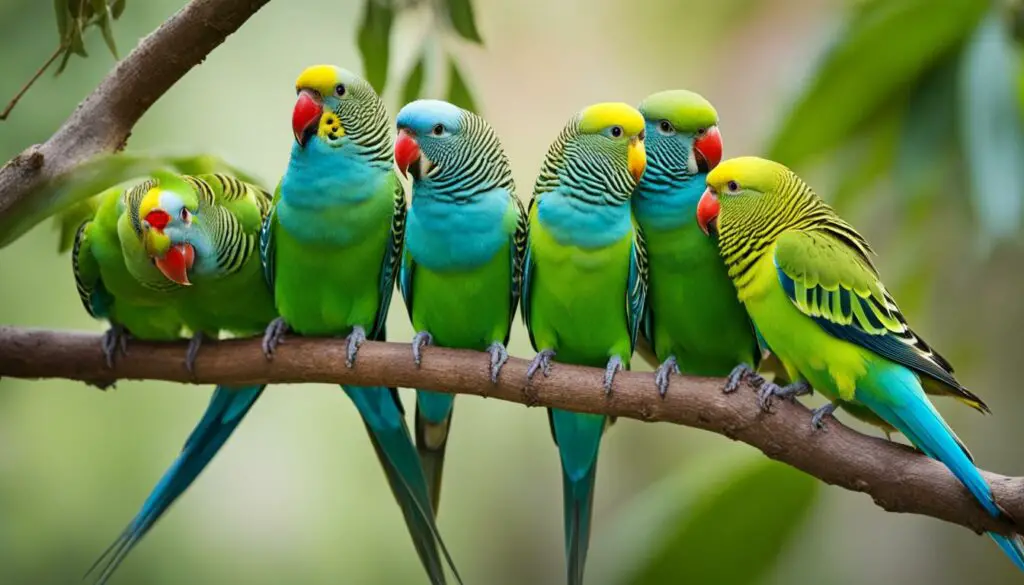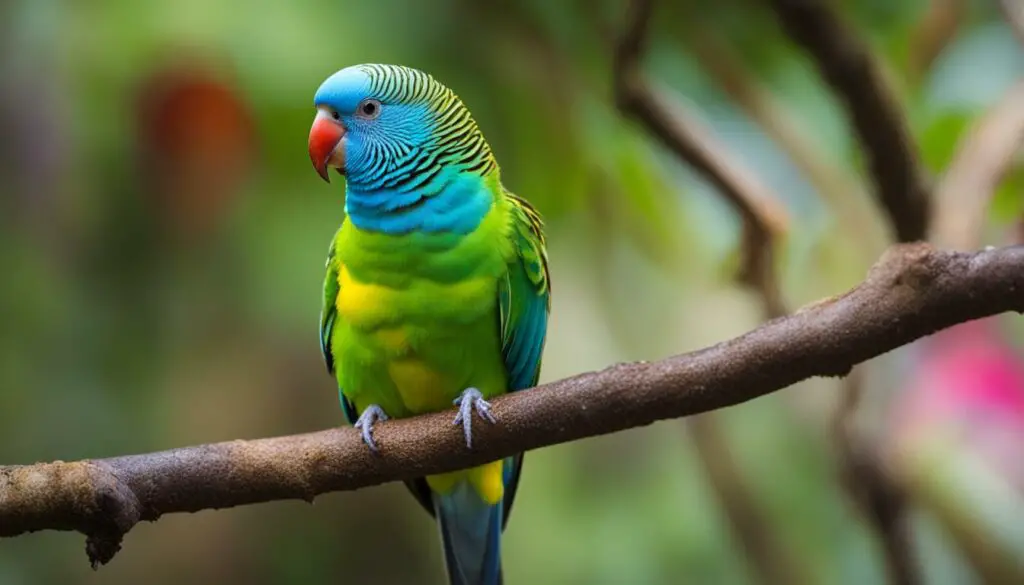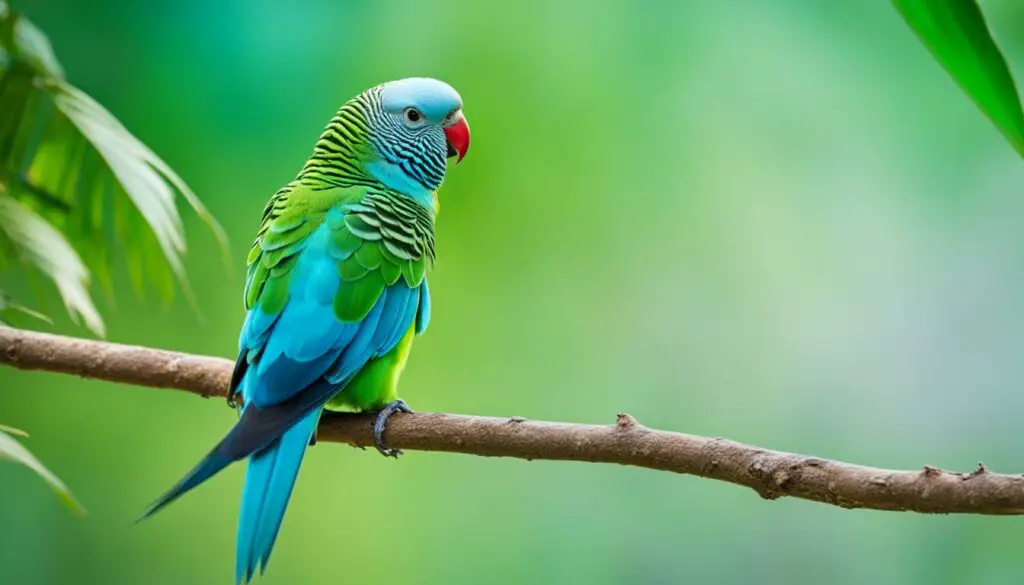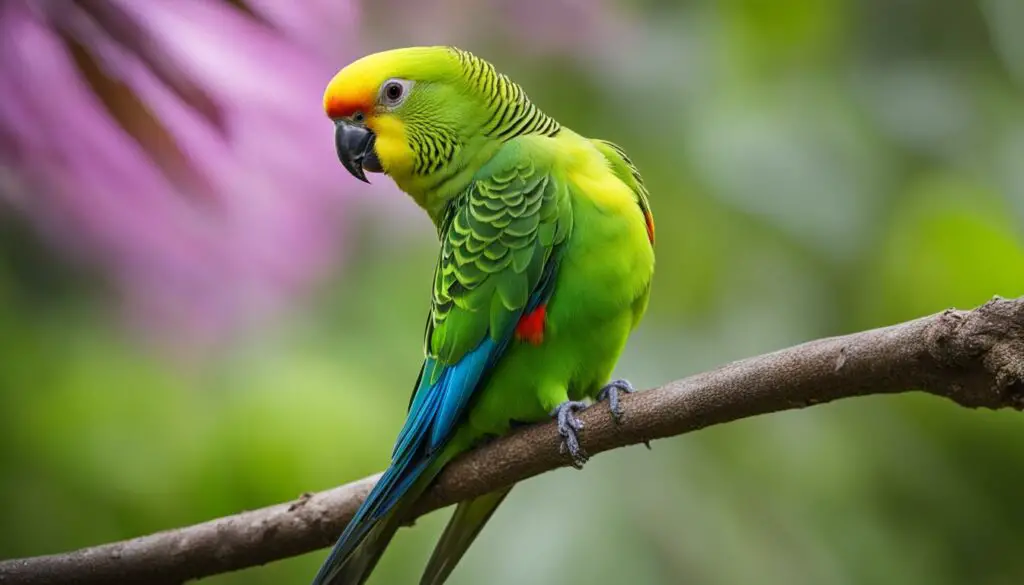Are you a parakeet owner looking to better understand your feathered friend’s chirping and vocalizations? Look no further! In this comprehensive guide, I will delve into the fascinating world of parakeet communication, helping you decipher and interpret their chirping sounds. By gaining insights into their behavior and unique language, you’ll be able to strengthen the bond with your beloved pet.
Key Takeaways:
- Parakeet chirping can convey different messages and emotions.
- Understanding the meaning of chirping sounds can help you meet your parakeet’s needs.
- Decoding other parakeet vocalizations, such as chattering and singing, provides further insight into their mood.
- Observing your parakeet’s body language is crucial in understanding its emotions.
- Squawking, hissing, and beak grinding also play a role in parakeet communication.
Understanding the Meaning of Chirping Sounds
When it comes to decoding your parakeet’s chirping, it’s essential to pay attention to the different sounds and context. A monotonous chirrup usually signifies contentment and reassurance. However, if the chirping becomes louder and repetitive, it may be an alert for a problem or a request for attention. A loud and insistent call can indicate excitement or a contact call to a fellow parakeet. On the other hand, if the chirping turns into squawking, it suggests alarm or dissatisfaction. By understanding the variations in chirping sounds, you can gain valuable insights into your parakeet’s needs and emotions.
“A monotonous chirrup usually signifies contentment and reassurance.”
It’s important to note that parakeet chirping can also be influenced by external factors such as changes in the environment or the presence of predators. By observing your parakeet’s behavior and body language alongside their chirping, you can better interpret their vocalizations. For instance, if your parakeet is chirping while flapping its wings or displaying feathers close to its body, it may be a sign of fear or stress. Understanding the context of your parakeet’s chirping can help you address their needs and ensure their well-being.
To assist you in decoding your parakeet’s chirping, below is a table summarizing the different meanings behind their vocalizations:
| Chirping Sound | Meaning |
|---|---|
| Monotonous chirrup | Contentment and reassurance |
| Loud and repetitive chirps | Alert for a problem or a request for attention |
| Loud and insistent call | Excitement or contact call to a fellow parakeet |
| Squawking | Alarm or dissatisfaction |

By paying close attention to your parakeet’s chirping and the accompanying body language, you can decipher their vocalizations and better understand their needs and emotions. This enhanced understanding will contribute to a healthier, happier bond between you and your feathered friend.
Deciphering Other Parakeet Vocalizations
In addition to chirping, parakeets produce various vocalizations that convey different messages. Understanding these vocalizations can help you gain insight into your parakeet’s mood and behavior. Here are some of the other vocalizations you may observe:
- Chattering: Parakeets often engage in chattering, which is a sign of contentment. It can also serve as a way for male parakeets to woo females. Chattering is characterized by a musical, mumbled conversation with themselves and can occur when parakeets interact with mirrors or other birds in their environment.
- Singing: While parakeets are not known for traditional singing like songbirds, they possess a unique vocal repertoire. Singing is a medley of chirrups, whistles, trills, and even human speech. Parakeets may “sing” together, which indicates their overall well-being and happiness.
- Hissing: Parakeets may produce a hissing sound, similar to “tssssk!” This sound is a warning to indicate that their personal space has been invaded or that they feel intimidated. Recognizing the hissing sound can help you create a suitable and comfortable environment for your parakeet.
- Beak Grinding: When a parakeet sits on a perch and makes a crackling, grinding sound with its beak, it is a sign of contentment and relaxation. Similar to a cat’s purr, beak grinding indicates that the parakeet is happy and likely preparing to settle down for a nap.
The Role of Chattering in Parakeet Communication
Chattering is an important form of communication among parakeets. It is often a sign of happiness and contentment. Parakeets will sit on their perches with slightly hunched shoulders and engage in a musical, mumbled conversation with themselves. Male parakeets may use chattering to attract the attention of female birds. Chattering can also occur when parakeets interact with mirrors or other birds in their environment. Understanding the significance of chattering can help you gauge your parakeet’s emotional state.
“My parakeet loves to chatter away in front of the mirror. It’s such a joy to see him so happy and content!” – Parakeet Owner
By paying attention to these different vocalizations, such as chattering, singing, hissing, and beak grinding, you can gain a deeper understanding of your parakeet’s mood and behavior. Remember that each parakeet is unique, and it’s important to observe your own bird’s communication patterns to decipher their individual meanings.

Observing Parakeet Body Language
Understanding your parakeet’s body language can provide valuable insights into its emotions and well-being. By observing their body postures, gestures, and overall demeanor, you can better understand your feathered friend’s needs and respond accordingly.
Feathers that are close to the body can indicate fear or stress in a parakeet. If you notice your parakeet’s feathers are ruffled or pressed tightly against its body, it may be a sign that it feels threatened or uncomfortable in its environment. Conversely, a parakeet with relaxed feathers that are slightly fluffed up is likely content and at ease.
Pay attention to your parakeet’s wing movements as well. Flapping or spreading wings can indicate unhappiness or a desire to be let out of its cage to stretch its wings and fly. On the other hand, a parakeet that is quietly perched, slightly fluffed-up, and engaging with other birds in the cage is likely content and socializing with its flock.
Another important aspect of parakeet body language is their beak and head position. A parakeet that holds its head down and opens its beak wide can be a sign of aggression or a warning to keep your distance. It’s important to give your parakeet space and avoid any actions that may be perceived as a threat.
Overall, by closely observing your parakeet’s body language, you can gain valuable insights into its emotions and well-being. This understanding will help you create a safe, comfortable environment for your feathered companion and strengthen the bond between you.
Table: Parakeet Body Language
| Body Language | Meaning |
|---|---|
| Feathers close to the body | Fear or stress |
| Relaxed slightly fluffed feathers | Content and at ease |
| Flapping or spreading wings | Desire for freedom or exercise |
| Quietly perched and socializing | Content and socializing with flock |
| Head down with open beak | Aggression or warning |
By paying attention to these body language cues, you can better understand your parakeet’s emotions and provide the care it needs to thrive.
The Role of Squawking in Parakeet Communication
Parakeets use squawking as a form of intense vocalization to communicate distress or anger. This loud and sharp sound is often triggered by various factors, such as fear, injury, perceived predators, or even dissatisfaction with food or water availability. Squawking can also be influenced by hormonal changes during the breeding season. When a parakeet squawks, it is important to address the underlying cause and provide a calm and supportive environment. Speaking to the parakeet gently and investigating the source of its distress can help alleviate the squawking behavior.

Squawking is the parakeet’s way of expressing its emotions and needs. It is crucial for parakeet owners to understand the meaning behind this vocalization and respond accordingly. By recognizing and acknowledging a squawking parakeet, you can create a more harmonious and comfortable environment for your feathered friend.
| Squawking | Meaning |
|---|---|
| Intense, loud, repeated squawks | Distress or anger |
| Alert, sharp squawks | Fear or perceived danger |
| High-pitched, insistent squawks | Request for attention or dissatisfaction |
“Understanding the role of squawking in parakeet communication is essential for providing a nurturing and supportive environment for your feathered companion.”
Next time you hear your parakeet squawking, take a moment to assess the situation and address any potential sources of distress. By doing so, you can establish a strong bond with your parakeet and ensure its overall well-being.
The Importance of Chattering in Parakeet Communication
Chattering is a common form of communication among parakeets that serves as a key indicator of their emotional state. When parakeets engage in chattering, they sit on their perches with slightly hunched shoulders and engage in a musical, mumbled conversation with themselves. This behavior is often a sign of happiness and contentment, as it signifies that the bird is settled and at ease in its environment.
Male parakeets also use chattering as a way to attract the attention of female birds. By emitting charming chatters, they display their interest and attempt to engage in courtship rituals. Additionally, chattering can occur when parakeets interact with mirrors or other birds in their environment, as it serves as a form of social bonding and communication.
Understanding the significance of chattering in parakeet communication can help you gauge your bird’s emotional well-being and overall satisfaction. By observing your parakeet’s chattering behavior and providing a suitable environment for social interaction, you can ensure that your feathered friend remains content and happy.

| Chattering Behavior | Significance |
|---|---|
| Hunched shoulders and mumbled conversation | Indicates happiness and contentment |
| Male parakeet chattering towards female birds | Signifies courtship and attempts to attract a mate |
| Chattering during interaction with mirrors or other birds | Serves as a form of social bonding and communication |
The Melodic “Song” of Parakeets
Parakeets, while not known for traditional singing like songbirds, possess a unique vocal repertoire that can be described as a melodic “song”. This medley of sounds includes chirrups, whistles, chattering, trills, and even human speech. When parakeets “sing” together, it is a sign of their overall well-being and happiness.
Unlike other species, parakeets do not have a set song structure or specific notes they follow. Instead, they combine various sounds to create a melodic symphony. By paying attention to their singing, you can gain insight into their emotional state and overall contentment.

The Warning Hiss of Parakeets
Parakeets have a unique way of expressing their discomfort or assertiveness through a warning hiss sound. This distinctive tssssk! noise serves as a clear communication that their personal space has been invaded or that they feel intimidated in an overcrowded environment. While some may find it alarming, it’s important to understand that hissing is a natural part of parakeet social dynamics, especially during crowded feeding sessions in larger aviaries.
Recognizing the hissing sound is crucial for creating a suitable and comfortable environment for your parakeet. It allows you to adjust their living space to ensure they feel secure and undisturbed. By providing enough personal space and minimizing overcrowding, you can help reduce instances of hissing and promote a sense of contentment in your parakeet.
Understanding your parakeet’s vocalizations, including the warning hiss, is key to establishing a strong bond with your feathered friend. By respecting their need for personal space and creating an environment where they feel safe, you can foster a harmonious relationship and ensure the well-being of your parakeet.

Table: How to Respond to Parakeet Hissing
| Situation | Response |
|---|---|
| Personal space invasion | Give your parakeet some distance and avoid reaching into their cage or handling them when they show signs of discomfort. |
| Overcrowding | Ensure your parakeet has enough space in their cage or aviary to move around comfortably. If necessary, consider providing separate feeding stations to minimize competition. |
| Feeding time conflicts | Establish a feeding schedule and ensure each parakeet has access to food and water without feeling the need to compete or defend their resources. |
| Territorial disputes | If you have multiple parakeets, provide enough perches, toys, and hiding spots to prevent territorial conflicts and reduce stress. |
The Happy Sound of Beak Grinding
Parakeets have a unique way of expressing their contentment and relaxation through a sound known as beak grinding. Similar to a cat’s purr, beak grinding is a gentle, crackling noise that parakeets make when they are happy and at ease. This behavior is often observed when the parakeet is perched on a comfortable spot, with its feathers slightly fluffed-up.
Beak grinding is a self-soothing behavior that parakeets engage in to relieve stress and promote relaxation. It is a sign that your parakeet feels safe and secure in its environment. By recognizing and understanding this happy sound, you can ensure that your parakeet’s needs are met and create a conducive atmosphere for its well-being.

Benefits of Beak Grinding for Parakeets:
- Relieves stress and promotes relaxation
- Indicates a sense of security and contentment
- Serves as a self-soothing mechanism
- Helps parakeets unwind before settling down for a nap
Beak grinding is a natural and healthy behavior for parakeets. It is an indication that your feathered friend is in a positive emotional state. By providing a safe and comfortable environment, along with a well-balanced diet and regular interaction, you can help your parakeet maintain its happiness and overall well-being.
| Common Reasons for Beak Grinding: | Associated Emotions |
|---|---|
| Feeling safe and secure | Contentment |
| Relaxed and stress-free environment | Relaxation |
| Healthy and well-fed | Comfort |
The Influence of Sounds on Parakeet Behavior
Parakeets have the remarkable ability to mimic and incorporate various sounds into their vocalizations, making them highly adaptable and engaging pets. These intelligent birds can learn and repeat pleasing sounds from their environment, such as phones ringing, music playing, or even human voices. Some parakeets may develop preferences for certain types of music or show a dislike for specific sounds.
When exposed to different sounds, parakeets can exhibit a range of behaviors. They may become more active, curious, or even mimic the sounds they hear. For example, a parakeet that frequently hears the sound of a phone ringing may start incorporating it into its repertoire of vocalizations. This ability to imitate sounds demonstrates their social and cognitive capabilities.
The Impact of Music
Music can greatly influence a parakeet’s behavior and mood. Research suggests that parakeets have preferences for certain types of music, with classical and calming melodies often having a positive effect on their well-being. Playing soothing music in the background can create a peaceful environment and help reduce stress in parakeets.
On the other hand, loud or harsh sounds may agitate parakeets and cause them to become anxious or distressed. It is important to create a harmonious living environment by avoiding sudden loud noises or exposure to prolonged periods of noise pollution.
Creating a Stimulating Environment
Providing a variety of sounds can help enrich a parakeet’s environment and keep them mentally stimulated. Incorporating natural sounds, such as recordings of chirping birds or gentle rainfall, can create a soothing ambiance that mimics their natural habitat. Additionally, playing recordings of other parakeets vocalizing can encourage social interaction and provide companionship for solitary birds.
It is essential to strike a balance between stimulating and overwhelming sounds. Pay attention to your parakeet’s reactions and adjust the volume and type of sounds accordingly. By understanding the impact of sounds on parakeet behavior, you can create a harmonious and enjoyable living environment for both you and your feathered friend.

| Sound | Effect on Parakeet Behavior |
|---|---|
| Soft classical music | Creates a calm and peaceful environment |
| Loud or harsh sounds | Can agitate and stress parakeets |
| Natural sounds (chirping birds, rainfall) | Mimics their natural habitat and soothes parakeets |
| Recordings of other parakeets vocalizing | Encourages social interaction and provides companionship |
Decoding Parakeet Talking Abilities
Parakeets, while not as renowned as some other parrot species for their talking abilities, can still learn to mimic words and phrases. Male parakeets, in particular, are adept at imitating human speech, producing high-pitched chirps while speaking at a fast pace. By consistently repeating words and maintaining clear pronunciation, parakeets can grasp and reproduce specific phrases, showcasing their intelligence and engagement with their human companions.
While parakeets may not achieve the same level of verbal fluency as certain other parrot species, their talking abilities are nonetheless impressive. By interacting with your parakeet regularly and teaching it basic words and phrases, you can foster an environment that encourages vocalization and language development.
My parakeet, Charlie, surprises me every day with his ability to mimic words and phrases. From a simple “hello” to more complex sentences, his talking abilities never cease to amaze me. It’s truly a testament to the unique and intelligent nature of these feathery companions.
It’s important to note that not all parakeets will develop talking abilities, as it depends on the individual bird’s disposition and willingness to learn. Additionally, while male parakeets tend to be more proficient at talking, some females may also pick up a few words with time and patience. Patience is key when teaching your parakeet to talk, as consistent repetition and positive reinforcement are essential for successful language acquisition.
While talking is not a natural behavior for parakeets, it is a delightful and fascinating aspect of their communication repertoire. By engaging with your parakeet and providing opportunities for vocalization, you can unlock their hidden talents and create a deeper bond with your feathered friend.
Table: Comparison of Talking Abilities in Different Parrot Species
| Parrot Species | Talking Abilities |
|---|---|
| African Grey Parrot | Highly skilled at mimicry, with the ability to learn a vast vocabulary and mimic human speech with exceptional clarity. |
| Amazon Parrot | Capable of learning a moderate vocabulary and producing a variety of sounds and phrases. |
| Cockatoo | Skilled at mimicry, with a tendency to learn and repeat a wide range of words and phrases. |
| Budgie/Parakeet | While not as proficient as other parrot species, some individuals can learn to mimic words and phrases, especially male parakeets. |

Exploring the Vocalization Habits of Budgies
Budgies, also known as parakeets, are highly vocal birds that use a wide range of sounds to communicate with both their fellow flock members and their human owners. Understanding and interpreting these vocalizations is crucial for building a strong bond with your feathered companions.
Parakeets engage in constant chatter, chirping, and singing, each with its unique meaning. Chirping is the most common vocalization, and it can vary in pitch, duration, and intensity. It serves as a way for parakeets to express their emotions and needs. From contentment and happiness to territoriality and distress, the various sounds they produce provide valuable insights into their inner world.
One fascinating aspect of budgie vocalizations is their ability to mimic environmental noises. They can imitate phones ringing, music playing, or even human speech. This mimicry demonstrates their intelligence and engagement with their surroundings. By paying close attention to the different sounds your budgie produces and the context in which they occur, you can decipher their meaning and respond accordingly.
To help you understand the vocalization habits of budgies, I’ve created a concise table summarizing the most common sounds they make and their possible interpretations:
| Vocalization | Meaning |
|---|---|
| Chirping | Contentment, happiness, or a request for attention |
| Squawking | Distress, alarm, or dissatisfaction |
| Singing | Overall well-being and happiness |
| Hissing | Warning or feeling threatened |
| Beak grinding | Relaxation and contentment |
Remember, each budgie may have its unique vocal repertoire and preferences. Take the time to observe and interact with your parakeet to develop a deeper understanding of their individual communication style. By doing so, you’ll create a harmonious and enriching environment for your budgie and strengthen the bond between you.

References:
- “Understanding Your Budgie’s Vocalizations.” The Budgie Book. Accessed October 27, 2021. https://www.thebudgiebook.com/understanding-your-budgies-vocalizations.html
- “Parakeet Sounds and Vocalizations: What Do They Mean?” The Spruce Pets. Accessed October 27, 2021. https://www.thesprucepets.com/parakeet-sounds-390299
- Parakeet Sounds: What Does It Mean? How to Understand?” Petsoid. Accessed October 27, 2021. https://petsoid.com/parakeet-sounds/
Conclusion
Throughout this parakeet chirping meaning guide, I have provided you with valuable insights into understanding your feathered friend’s communication. By deciphering parakeet vocalizations, observing their body language, and recognizing their unique behaviors, you can build a stronger bond with your pet.
Parakeets use chirping as a way to convey various messages, from contentment to distress. Understanding the different sounds and their meanings can help you interpret your parakeet’s needs and emotions. Additionally, paying attention to their body language, such as feathers, wings, and beak positions, can provide further clues about their mood and behavior.
Chattering, singing, hissing, and beak grinding are all additional forms of communication that parakeets utilize. Decoding these vocalizations allows you to gauge your parakeet’s emotional state and overall well-being. By creating a harmonious environment and responding to their needs, you can ensure your parakeet feels safe, content, and happy.
As a responsible parakeet owner, it’s important to establish a strong connection with your bird by actively listening and engaging with them. By following the guidance and tips provided in this guide, you can become an expert in interpreting and responding to your parakeet’s vocalizations, ultimately deepening your bond and creating a loving companion for life.
FAQ
What does parakeet chirping mean?
Parakeet chirping can have different meanings depending on the sound and context. A monotonous chirrup usually signifies contentment and reassurance.
How do I know if my parakeet is in distress?
If your parakeet’s chirping becomes louder and repeated, it may be an alert for a problem or a request for attention. Squawking is a more intense vocalization that signals distress or anger.
What does chattering indicate in parakeets?
Chattering is a sign of a happy and settled bird and can also serve as a way for male parakeets to woo females.
What does it mean when a parakeet sings?
Singing is an indication that a parakeet is feeling good. It is a medley of chirrups, whistles, and trills that happy parakeets create.
How can I understand my parakeet’s mood through body language?
Feathers close to the body can indicate fear or stress, while flapping or spreading wings may signal unhappiness. A quiet and slightly fluffed-up bird engaging with others is likely content.
Why do parakeets squawk?
Squawking is a more intense vocalization that parakeets use to communicate distress or anger. It can be triggered by fear, injury, perceived predators, or dissatisfaction with their environment.
What is the significance of chattering in parakeet communication?
Chattering is a common form of communication among parakeets and is often a sign of happiness and contentment.
Do parakeets sing?
While parakeets are not known for traditional singing like songbirds, they possess a unique vocal repertoire and can create a medley of sounds.
Why do parakeets hiss?
Parakeets may hiss as a warning to indicate that their personal space has been invaded or that they feel intimidated in an overcrowded environment.
What does beak grinding mean in parakeets?
Beak grinding is a sign of contentment and relaxation in parakeets. It is similar to a cat’s purr and indicates that the bird is happy and likely preparing to settle down for a nap.
How do sounds affect parakeet behavior?
Parakeets can learn and incorporate various sounds into their vocalizations. They can be influenced by their environment and may mimic pleasing sounds or develop preferences for certain types of music.
Can parakeets talk?
While not known for talking abilities like some other parrot species, male parakeets can learn to mimic words and phrases with frequent repetition and clear pronunciation.
How vocal are budgies?
Budgies, also known as parakeets, are highly vocal birds. They engage in constant chatter, chirping, and singing to communicate with their flock members and human owners.








